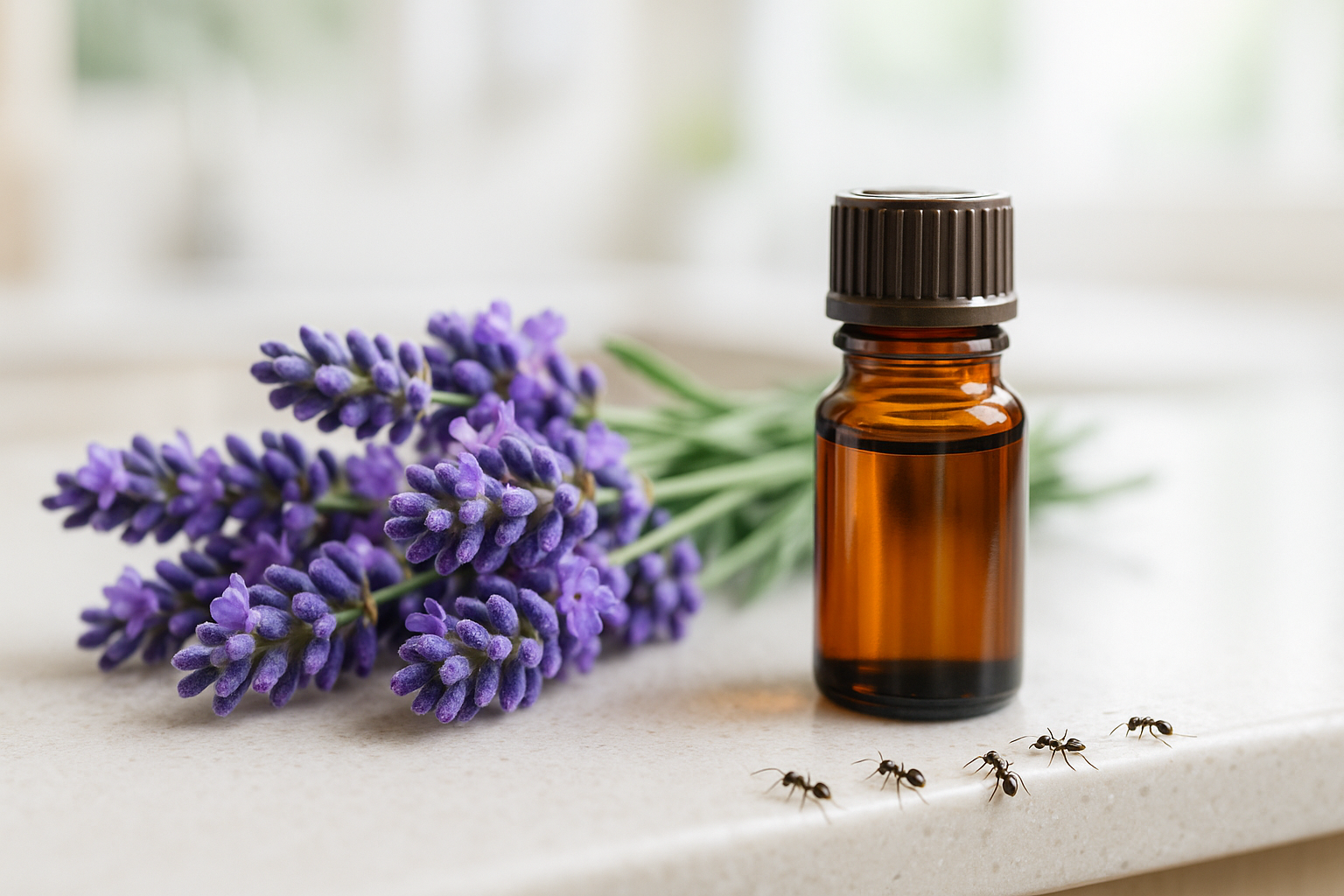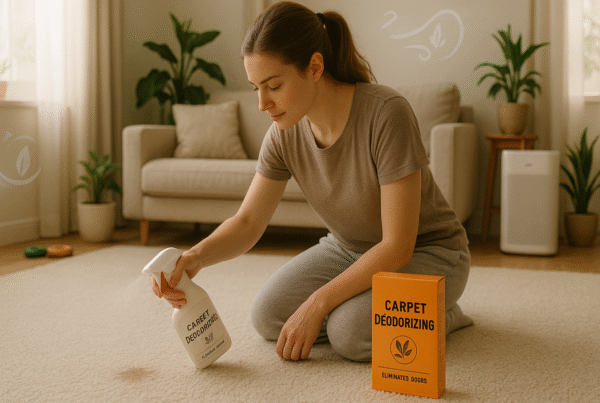Lavender ant repellent offers a safe and natural way to combat those pesky kitchen bugs. Its strong, relaxing smell is pleasant for people, but it repels ants. Lavender disrupts the scent paths ants use to find their way and communicate with each other, making them confused and unable to invade your space effectively. It’s a two-for-one fix; it calms you down and throws the ants off.
Does lavender chase away ants as well as chemical sprays? You bet it does. When used correctly, lavender oil creates a barrier that prevents ants from entering and spreading throughout your house. Moreover, it’s non-toxic, making it safer for homes with children or pets—no nasty fumes, no harmful side effects, just pure, plant-based protection that smells nice.
This guide explains the science behind why lavender works and provides handy ways to use it. You’ll learn how to keep ants out, and well, from essential oil sprays to placing cotton balls and mixing your solutions.
Does Lavender Repel Ants? The Science Behind It
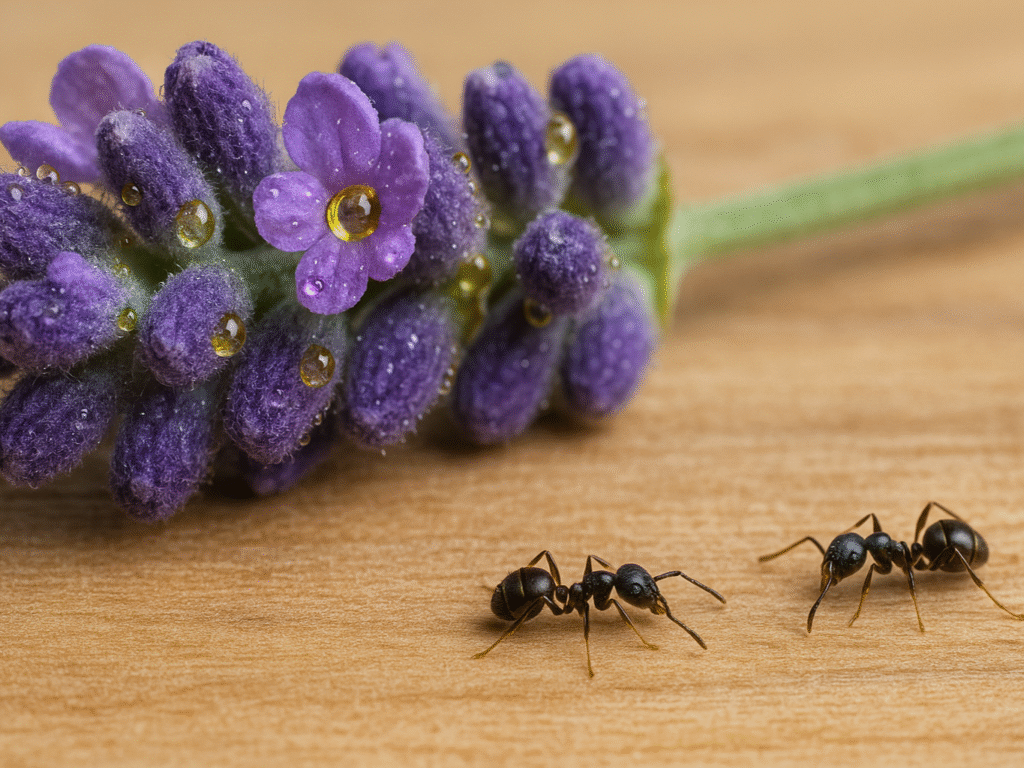
The science behind lavender’s ant-repelling properties reveals fascinating insights into insect behavior and plant chemistry interactions. Many gardeners and homeowners have observed lavender’s effectiveness against ants, yet understanding the mechanisms behind this natural phenomenon helps explain why it works so well. Let’s explore the scientific reasons behind lavender’s reputation as an effective ant deterrent.
1. How ants use scent trails to navigate
Ants possess remarkably sophisticated navigation systems, despite their relatively small brains. Unlike humans, who rely primarily on sight, ants depend heavily on their sense of smell to interact with their environment. These industrious insects don’t have noses; instead, they detect scents through highly sensitive chemoreceptors located on their antennae. These specialized sensory organs allow ants to interpret chemical signals with extraordinary precision.
The foundation of an ant society relies on chemical communication. Their entire social structure and foraging success depend on their ability to leave and follow scent trails. Worker ants establish these chemical pathways using pheromones, special compounds that serve as communication signals between members of the same species.
Here’s how the process typically works:
- Scout ants venture out from the colony in search of food sources
- Upon finding food, they leave a pheromone trail on their return journey
- Other worker ants follow this chemical path to the food
- More ants reinforce successful trails by adding their pheromones
Ants use olfactory cues to navigate, find food, and guide their nestmates, functioning like a built-in GPS. Research confirms that these chemical trails are essential for organization and efficiency in ant colonies, making them a primary target for natural disruption methods, such as those found in lavender or peppermint.
Many U.S. ant species depend entirely on these pheromone trails for survival. This reliance creates a vulnerability: certain plant-based compounds can interfere with their navigation. Using natural ant repellents that target this system can effectively protect both indoor spaces and garden areas.
2. Why lavender disrupts ant behavior
Lavender’s ability to repel ants stems from its interference with their scent-based navigation system. The potent aromatic compounds in lavender essentially create “signal noise” that crushes and confuses the ants’ sensitive chemoreceptors.
The essential oils found in lavender plants contain potent compounds that disrupt ants’ ability to follow their pheromone trails. As one scientific source explains, “By disrupting the ant’s scent trails, lavender creates a confusing environment that hinders the ant’s food location process. In simple terms, it messes with their ‘GPS.’”
This disruption occurs through several mechanisms:
- Sensory overload: Lavender’s strong aroma dominates the ants’ chemoreceptors, making it difficult for them to detect their pheromone signals
- Trail interference: The volatile compounds in lavender can physically interfere with or mask the chemical markers ants leave behind
- Navigational confusion: Without clear pheromone signals, ants become disoriented and unable to maintain their standard foraging patterns
Research demonstrates that foraging ants exhibit distinct phobic responses when exposed to lavender oil. Scientific studies have observed that ants encountering lavender oil along their foraging paths show significant behavioural changes, including “detouring around new or unfamiliar objects, meandering more, and scanning the environment more frequently”.
Beyond its simple repellent properties, lavender triggers what scientists describe as neophobia in ants, a fear response to new or unfamiliar stimuli that potentially signals danger. It explains why ants don’t simply power through lavender-treated areas but actively avoid them, often choosing completely different paths or even returning to their nest rather than crossing a lavender oil barrier.
3. Do ants hate lavender? What research says
Scientific studies confirm that ants strongly avoid lavender due to its intense aroma. Research shows it disrupts their chemical signals, making navigation difficult. This natural aversion makes lavender an effective, non-toxic solution for repelling ants, eliminating the need for harsh chemicals.
One study on bull ants found that 78% avoided lavender oil entirely, while 22% turned back to their nests. Compared to eucalyptus or olive oil, lavender caused more detours and hesitation, proving it’s one of the most potent natural ant repellents available.
Moreover, researchers found that ants exposed to lavender demonstrated several measurable behavioural changes:
- Significantly reduced travel speed
- Increased frequency of direction changes
- More scanning behavior (looking around)
- Longer journey times through affected areas
- Complete avoidance where possible
Studies show ants initially avoid lavender due to neophobia, a fear of new stimuli, rather than chemical aversion. Over time, their extreme avoidance lessens with repeated exposure. Still, this strong first reaction makes lavender highly effective for short-term, natural ant control.
Beyond ants, lavender repels various pests like mosquitoes and flies. Its natural compounds interfere with insect sensory systems. Remarkably, what smells calming to humans is overwhelming to bugs. Research confirms lavender’s broad-spectrum effect as a reliable, multi-purpose insect repellent. For those interested in expanding their natural pest control arsenal, learning about other ant repellent plants creates a comprehensive, chemical-free defense system throughout your home and garden.
Lavender oil confuses ants by disrupting their pheromone trails and communication. Scientific evidence supports its effectiveness in repelling ants. For homeowners seeking safe, chemical-free pest control, lavender offers a pleasant, research-backed solution that works naturally and has a lovely scent indoors.
How to Use Lavender Oil for Ant Control
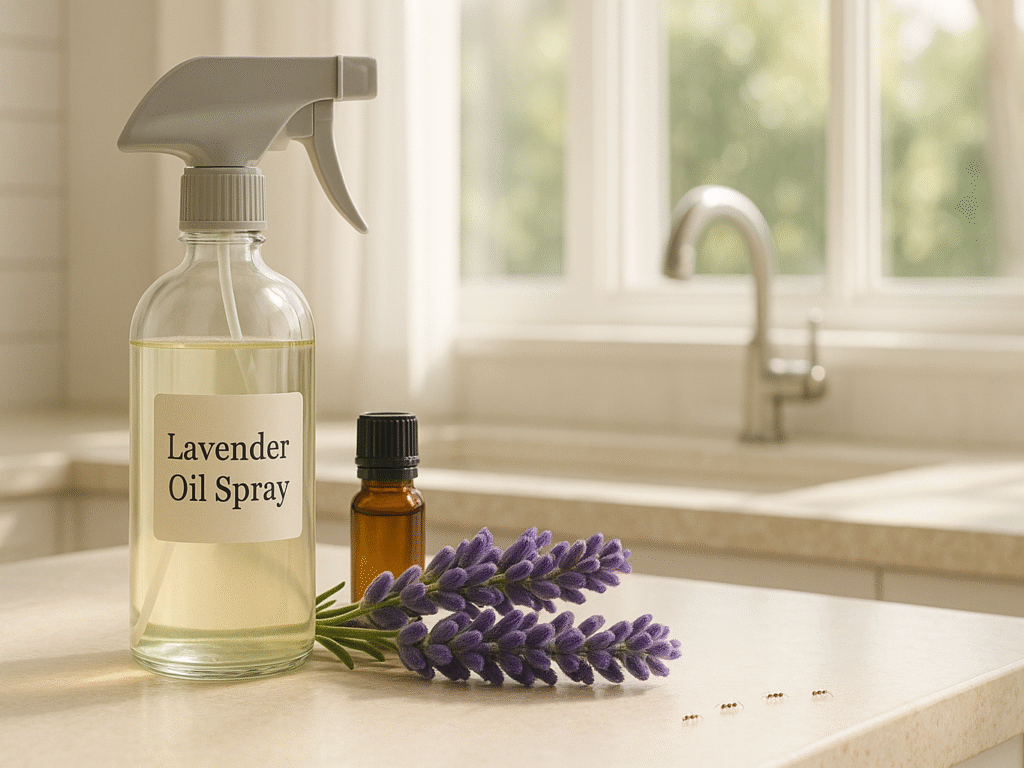
Now that you understand the science behind why ants avoid lavender, let’s explore practical ways to use this knowledge. Turning lavender’s natural properties into an effective ant control strategy requires the proper preparation, application techniques, and safety considerations.
1. Making a lavender oil spray at home
Creating your lavender ant repellent at home is a straightforward and cost-effective process. You’ll need just a few basic ingredients to get started.
For the most straightforward spray recipe, fill a bottle with 30 ml of water and add 10-15 drops of lavender essential oil. Mix the solution by stirring or shaking for approximately 30 seconds, until it is well combined. Transfer this mixture to a clean spray bottle with a secure lid.
If you prefer making lavender oil from scratch, you can create your own using dried lavender flowers:
- Gather dried lavender flowers, a carrier oil (almond or olive oil works well), and a sealed glass container
- Place the dried flowers in the glass jar
- Pour enough carrier oil to cover the flowers completely
- Seal the jar tightly and store it in a cool, dark place for at least 48 hours
- After this period, strain the mixture and transfer the oil to a dark bottle for storage
The homemade lavender oil serves multiple purposes beyond ant control; it can be used in aromatherapy, skincare, or other household applications. For ant control specifically, dilute this homemade oil with water in a spray bottle at a ratio of approximately 10-15 drops per 30ml of water.
Many homeowners report that store-bought lavender essential oil is more effective due to its higher concentration and more potent scent. Indeed, the potency of commercial oils often exceeds what can be achieved through home extraction methods.
Natural Ant Repellent for Garden: 8 Proven Ways to Protect Plants Without Chemicals. Discover comprehensive outdoor ant control methods that complement your indoor lavender solutions. Learn chemical-free garden protection techniques that keep ants away from plants while maintaining a healthy ecosystem for your family. Click here to explore proven garden ant repellent methods.
2. Where to apply lavender oil indoors
Strategic application is crucial for maximizing the effectiveness of lavender oil against ants. Focus on areas where ants commonly appear or might enter your home.
The kitchen deserves special attention as it’s typically the primary target for ant invasions. Apply your lavender solution around:
- Countertops (especially near food preparation areas)
- Cabinet edges and corners
- Food storage areas
- Trash can perimeters
- Doorways and window sills
Beyond the kitchen, identify and treat all potential entry points throughout your home. These often include small cracks near doors, windows, baseboards, and utility penetrations. Spraying these areas creates a barrier that discourages ants from entering.
For existing ant problems, apply the lavender solution directly on visible ant trails. It disrupts their chemical communication system, confusing the colony. Furthermore, concentrate application around food sources or areas where food might be left exposed, as these are prime attractions for ants.
The cotton ball method offers another effective application technique. Soak cotton balls in lavender oil and place them strategically near any entry points. It creates a scent barrier that deters ants without directly spraying surfaces.
3. How long does lavender repel ants?
Understanding the duration of lavender’s effectiveness helps establish an appropriate reapplication schedule. Unlike chemical pesticides, which may remain active for weeks or months, natural solutions typically require more frequent application.
Lavender oil’s repellent properties gradually diminish as the volatile compounds that make up the oil evaporate. Regular reapplication ensures consistent protection against ant invasions. For most indoor applications, you’ll likely need to reapply the solution every 3-5 days, especially in high-traffic areas or during peak ant season.
Several factors influence how long lavender effectively repels ants:
- Environmental conditions (temperature, humidity, airflow)
- Initial concentration of the solution
- Quality of the essential oil used
- Surface type where applied
- Severity of the ant infestation
Interestingly, research indicates that ants’ avoidance response to lavender may decrease over time with repeated exposure. It suggests that occasionally alternating between different natural repellents might maintain maximum effectiveness.
For ongoing protection, consider establishing a regular maintenance schedule rather than waiting until you spot ants again. Preventive applications are more effective than reactive treatments after an infestation has already established itself.
4. Precautions when using around pets and kids
Although lavender oil provides a natural alternative to chemical pesticides, specific safety considerations must be observed, particularly in households with children and pets.
Lavender oil is generally considered safe around pets when used in small quantities and properly diluted. It can even have a calming effect on some animals. Nevertheless, never apply undiluted essential oils directly to pets or in areas where they might come into direct contact with concentrated oil.
For households with cats, exercise additional caution. Cats lack certain liver enzymes needed to metabolize some compounds found in essential oils. Always ensure any lavender solutions are thoroughly dried before allowing cats access to treated areas. For comprehensive guidance on pet-safe options, consulting resources about animal-safe ant repellent methods helps ensure complete household safety while maintaining effective pest control.
If you have pets, consider these safety guidelines:
- Always dilute lavender oil properly before use
- Keep spray bottles out of reach of curious pets
- Avoid applying directly to pet bedding or favorite resting spots
- Consult your veterinarian if you notice any adverse reactions
- Apply in small areas first to monitor for any pet sensitivity
Similarly, take precautions with children in the home. Store both the concentrated oil and prepared solutions out of children’s reach. Additionally, avoid applying large quantities of lavender oil directly to the skin, as concentrated essential oils can irritate some individuals.
For both pets and children, prioritize application in areas less likely to have direct contact, such as higher surfaces, cracks, and crevices. After spraying, allow surfaces to dry completely before children or pets access the area.
By following these guidelines, you can effectively use lavender oil for ant control while maintaining a safe environment for all household members. The combination of strategic application and proper safety measures makes lavender a practical, natural solution for your ant problems.
Animal-Safe Ant Repellent Guide: Protect Your Pets While Getting Rid of Ants. Ensure complete safety for your furry family members with pet-specific ant control strategies. Learn which natural repellents are safest for different animals and how to create practical barriers without risking pet health.
6 Best Lavender Products That Repel Ants Naturally
When it comes to choosing the best lavender ant repellent, selecting quality products makes all the difference. These carefully curated lavender ant repellent options offer proven effectiveness against ant invasions while maintaining the pleasant, calming fragrance for which lavender is known. Each product harnesses lavender’s natural compounds to create barriers that demonstrate lavender’s effectiveness in repelling ants, as supported by scientific research.
| Product Name | Type | Size | Price Range | Concentration | Purchase Link |
| NOW Essential Oils Lavender | Pure Oil | 4 oz | $15-20 | 100% Pure | Buy on Amazon |
| Plant Therapy Organic Lavender | Organic Oil | 1 oz | $12-18 | 100% Organic | Buy on Amazon |
| Rocky Mountain Oils Lavender | Premium Oil | 0.5 oz | $18-25 | GC/MS Tested | Buy on Amazon |
| Mighty Mint Lavender Spray | Ready Spray | 16 oz | $20-28 | Diluted Formula | Buy on Amazon |
| Eco Defense Lavender Spray | Natural Spray | 32 oz | $25-35 | Plant-Based | Buy on Amazon |
| Aura Cacia Lavender Oil | Value Oil | 4 oz | $8-15 | Therapeutic Grade | Buy on Amazon |
1. NOW Essential Oils 100% Pure Lavender Oil
This premium therapeutic-grade lavender essential oil provides maximum potency for ant control applications. Sourced from authentic Lavandula angustifolia plants, this lavender ant repellent delivers concentrated aromatic compounds that overwhelm ants’ sensory systems. The high-quality extraction process ensures consistent effectiveness while preserving the oil’s natural therapeutic properties, making it safe for use around family members.
How to Use NOW Essential Oils Lavender Oil
- Direct Application: Add 10-15 drops to cotton balls and place near ant entry points, windowsills, and baseboards for targeted protection
- Spray Creation: Mix 15 drops with 30ml of water in a spray bottle, shake well, and apply to ant trails and problem areas
- Perimeter Defense: Create barriers by applying a diluted solution around doorways, kitchen cabinets, and food storage areas
- Maintenance Schedule: Reapply every 3-4 days or when lavender scent begins to fade for continuous ant deterrence
- Combination Method: Blend with peppermint oil for enhanced effectiveness against persistent ant colonies
This best lavender ant repellent works because its pure concentration contains maximum levels of linalool and linalyl acetate, the specific compounds that disrupt ant pheromone communication.
The therapeutic-grade quality ensures volatile compounds remain active longer, providing extended protection. Does lavender oil repel ants as effectively as chemical alternatives? This concentrated formula proves it does, with research showing similar disruption patterns to synthetic repellents.
2. Plant Therapy Lavender Essential Oil, Organic
Certified organic lavender oil provides chemical-free ant control, backed by USDA organic certification, ensuring purity. This lavender-based ant repellent contains no synthetic additives or pesticide residues, making it an ideal choice for households that prioritize natural solutions. The organic cultivation process preserves the plant’s natural repellent compounds while maintaining environmental sustainability standards.
How to Use Plant Therapy Organic Lavender Oil
- Kitchen Protection: Apply a diluted solution around countertops, sinks, and food preparation areas where ants commonly appear
- Entry Point Treatment: Place oil-soaked cotton swabs in cracks, crevices, and gaps where ants enter your home
- Natural Barriers: Create scent lines using diluted spray along baseboards and under appliances where ants travel
- Furniture Protection: Apply sparingly to cabinet exteriors and pantry surroundings to prevent ant exploration
- Outdoor Application: Use around patio doors, windows, and deck areas to deter ants from approaching your home
The organic certification guarantees that the best lavender ant repellent maintains its natural compound integrity without chemical interference. Does lavender repel ants more effectively when grown organically? Studies suggest organic essential oils retain higher concentrations of active compounds, making them more potent against insect pests. The absence of synthetic chemicals means ants cannot develop resistance mechanisms.
3. Rocky Mountain Oils Lavender Essential Oil
This premium lavender oil undergoes rigorous third-party testing for purity and potency, ensuring consistent ant-repelling effectiveness. The company’s GC/MS testing ensures the authenticity of lavender compounds while eliminating potential adulterants that could compromise effectiveness. This lavender ant repellent provides reliable results backed by scientific analysis and quality assurance.
How to Use Rocky Mountain Oils Lavender Oil
- Precision Application: Use a dropper bottle for exact measurements when creating DIY ant repellent sprays and solutions
- Surface Treatment: Apply a diluted mixture to clean surfaces where ants have been spotted for an immediate deterrent effect
- Preventive Measures: Treat potential problem areas before the ant season begins to establish protective barriers early
- Concentration Adjustment: Start with lighter concentrations and increase strength for stubborn ant problems as needed
- Multi-Room Protection: Apply systematically throughout the home, focusing on the kitchen, bathroom, and entry areas
The third-party testing ensures that the best lavender ant repellent contains optimal levels of ant-deterring compounds. Does lavender oil repel ants consistently? This product’s quality control measures guarantee batch-to-batch consistency in effectiveness. The pure extraction process preserves the natural molecular structure that makes lavender overwhelming to ants’ sensitive chemoreceptors.
4. Mighty Mint Lavender-Peppermint Natural Ant Spray
This ready-to-use spray combines the gentle effectiveness of lavender with the powerful repellent properties of peppermint. The lavender ant repellent formula requires no mixing or preparation, offering immediate application convenience. The dual-oil approach creates a comprehensive sensory barrier that overwhelms ants from multiple angles while maintaining a pleasant household fragrance.
How to Use Mighty Mint Lavender-Peppermint Spray
- Immediate Treatment: Spray directly on visible ant trails to disrupt their pheromone communication system instantly
- Preventive Application: Apply weekly to high-risk areas, including kitchen perimeters, pantry surroundings, and entry points
- Spot Treatment: Target specific problem areas where ants repeatedly appear for concentrated protection
- Outdoor Barriers: Create protective zones around doors, windows, and patio areas to prevent any entry
- Maintenance Program: Establish a regular spraying schedule during peak ant season for continuous protection
The combination of lavender and peppermint creates a synergistic effect that does lavender repel ants more effectively than single oils. This best lavender ant repellent targets multiple aspects of ant behavior simultaneously, making it difficult for ants to adapt or develop tolerance. The ready-to-use formula maintains optimal dilution ratios for maximum effectiveness.
10 Powerful Ant Repellent Plants That Actually Work (Indoors & Outdoors) Expand your natural ant defense with strategic plant placement. These scientifically proven plants create living barriers that repel ants year-round, offering sustainable protection for both indoor and outdoor spaces. Learn about the most effective plants for repelling ants.
5. Eco Defense Natural Lavender Ant Repellent Spray
This botanical-based spray focuses exclusively on lavender’s ant-repelling properties while remaining safe for indoor use around pets and children. The lavender ant repellent formulation utilizes plant-derived surfactants to enhance adhesion and prolong the effectiveness on treated surfaces. The eco-friendly approach provides effective ant control without environmental concerns.
How to Use Eco Defense Lavender Ant Spray
- Indoor Safety: Apply liberally in kitchens, dining areas, and food storage locations without safety concerns for family members
- Pet-Friendly Treatment: Use around pet feeding areas and bedding where chemical sprays would be inappropriate
- Long-Term Protection: Apply to baseboards, door frames, and window sills for extended barrier protection
- Food-Safe Application: Spray around food preparation surfaces and dining areas with confidence in ingredient safety
- Child-Safe Zones: Treat children’s play areas, bedrooms, and common areas without toxic chemical exposure risks
This best lavender ant repellent prioritizes safety without compromising effectiveness through careful formulation of plant-based ingredients. Does lavender oil repel ants as safely as it does effectively? This product proves that both can be achieved through intelligent botanical combinations. The non-toxic formula means families can use it liberally without health concerns.
6. Aura Cacia Pure Lavender Essential Oil
This widely available lavender oil offers consistent quality at an accessible price point, making natural ant control affordable for all households. The lavender ant repellent maintains therapeutic-grade standards while providing economical ongoing protection. The 4-ounce bottle offers excellent value for creating multiple batches of DIY ant repellent solutions.
How to Use Aura Cacia Lavender Oil
- Budget-Friendly Solutions: Create large batches of ant repellent spray for comprehensive home treatment at minimal cost
- Multiple Applications: Use for cotton ball method, spray creation, and direct application techniques interchangeably
- Seasonal Preparation: Stock up for any season with affordable, shelf-stable natural protection that stores well
- Experimentation: Try different dilution ratios and application methods to find optimal effectiveness for your situation
- Bulk Treatment: Apply throughout the entire home without concern about product cost or availability
The therapeutic-grade quality ensures this lavender ant repellent contains active compounds necessary for ant deterrence despite its affordable price. Does lavender repel ants cost-effectively? This product demonstrates that natural ant control doesn’t require premium pricing to achieve results. The consistent quality control maintains effectiveness across all bottles and batches.
Lavender Ant Repellent DIY Recipes You Can Try
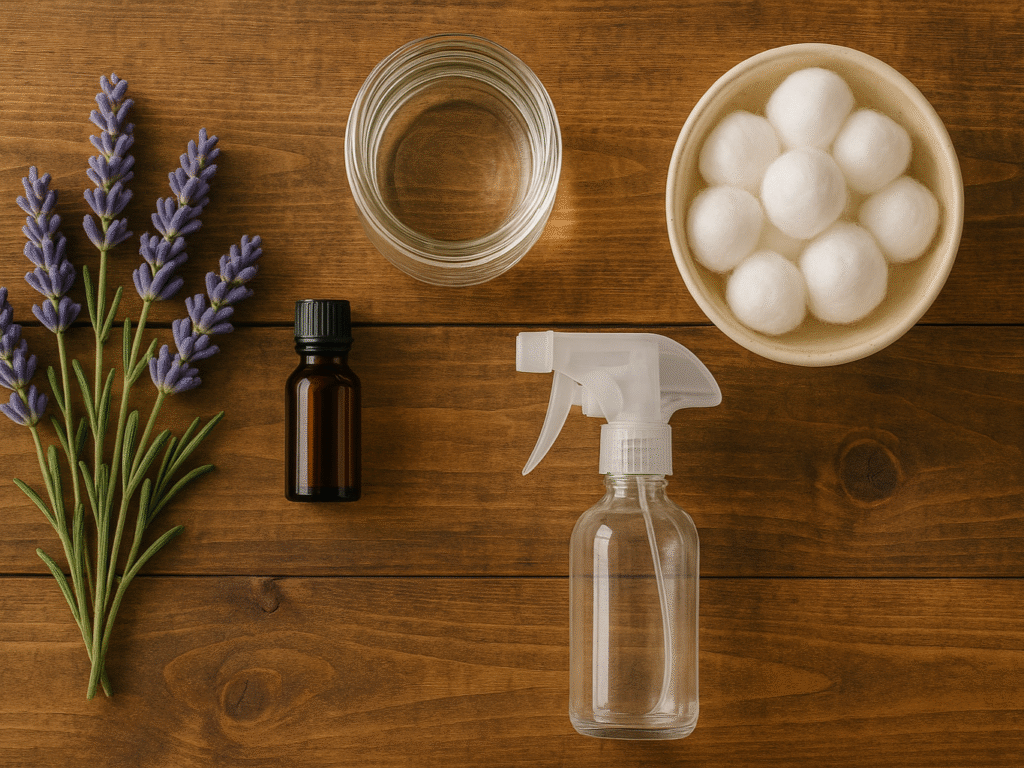
Creating your lavender-based ant repellents at home provides an affordable and customizable solution for keeping ants at bay. These simple DIY recipes require minimal ingredients yet provide maximum effectiveness against unwanted insect visitors. Each recipe harnesses lavender’s natural ant-repelling properties in slightly different ways, allowing you to choose the method that works best for your specific situation.
1. Simple lavender spray with water
The most straightforward lavender ant repellent requires just two ingredients: water and lavender essential oil. To create this effective spray, mix 10-15 drops of lavender essential oil with one cup of water in a clean spray bottle. Shake the mixture thoroughly for about 30 seconds to ensure the oil is evenly distributed throughout the water.
This environmentally friendly solution costs considerably less than commercial pesticides. High-quality lavender oil can be purchased for around £2 (approximately $2.50) at many retailers, making this an economical choice for ongoing ant control.
For optimal results, apply this spray along common ant entry points, including windowsills, door frames, baseboards, and any minor cracks that might serve as access routes. The potent lavender scent creates an invisible barrier that ants will typically avoid crossing. An additional benefit: your home will smell pleasantly fragrant as you deter these unwanted guests.
2. Lavender and peppermint combo spray
When dealing with more persistent ant problems, combining lavender with peppermint creates a powerhouse repellent that few ants can tolerate. Initially, gather your ingredients: lavender essential oil, peppermint essential oil, water, and a spray bottle.
To prepare this enhanced solution, add several drops of each lavender and peppermint oil to a spray bottle filled with water. The exact measurements depend on your preference, yet approximately 5-7 drops of each oil per cup of water typically works well. Subsequently, shake the bottle vigorously to blend the oils.
This combination works remarkably well since both oils contain compounds that disrupt ants’ scent trails. In effect, the combination of the two oils creates a more substantial barrier than either oil alone. The peppermint’s pervasive smell complements lavender’s repellent properties, forming an effective natural insect repellent spray.
Apply this mixture in areas frequently visited by ants to break their scent trails and deter new invasions. The refreshing aroma makes this solution particularly pleasant for use in the kitchen and living area.
3. Lavender oil cotton ball method
For targeted ant control in specific problem areas, the cotton ball method offers a simple yet effective approach. This technique concentrates lavender oil in strategic locations without directly spraying surfaces.
To implement this method, place cotton balls soaked in lavender oil near all entry points. Given that these points are correctly identified, the cotton balls create a scent barrier that effectively prevents ants from crossing. For this purpose, add a few drops of lavender oil to each cotton ball until slightly dampened but not dripping.
The cotton ball technique works exceptionally well for:
- Small cracks and crevices where sprays might not reach
- Areas where liquid application isn’t ideal
- Entry points near electronics or sensitive surfaces
- Creating perimeter barriers around food storage areas
Replace the cotton balls every 3-4 days or whenever the scent begins to fade to maintain continuous protection against any intrusions.
10 Essential Oils That Repel Ants Naturally (And How to Use Them) Master the complete arsenal of natural ant-fighting essential oils. This comprehensive guide reveals application techniques, dilution ratios, and effectiveness ratings for all top-performing oils, including those beyond lavender.
4. Homemade lavender oil from dried flowers
For those interested in a fully DIY approach, making lavender oil from scratch provides a rewarding and effective option. This method requires more time but yields an all-natural product with multiple uses beyond ant control.
To create homemade lavender oil, you’ll need:
- Dried lavender flowers (dehydrated to prevent mold growth)
- A carrier oil, such as olive or sweet almond oil
- A sealed glass container
- Cheesecloth or a fine-mesh strainer for filtering
The process involves these straightforward steps:
- Place dried lavender flowers in a clean glass jar, filling it at least three-quarters full
- Pour your chosen carrier oil over the flowers until they’re fully submerged
- Seal the jar tightly and store it in a dark, cool place for a minimum of 48 hours
- For a more substantial infusion, leave the mixture for up to one month
- After sufficient infusion time, strain the oil through cheesecloth, squeezing to extract every bit
- Store the finished oil in a dark bottle to preserve its properties
The resulting lavender-infused oil won’t be as concentrated as commercial essential oils but contains sufficient aromatic compounds to repel ants effectively when used in the previously described recipes. Furthermore, this homemade oil has multiple uses, including skincare applications and aromatherapy.
For enhanced ant-repelling properties, consider adding a few drops of commercially available lavender essential oil to your homemade infusion. It boosts its effectiveness while maintaining the natural quality of your DIY solution.
Combining Lavender with Other Natural Ant Repellents
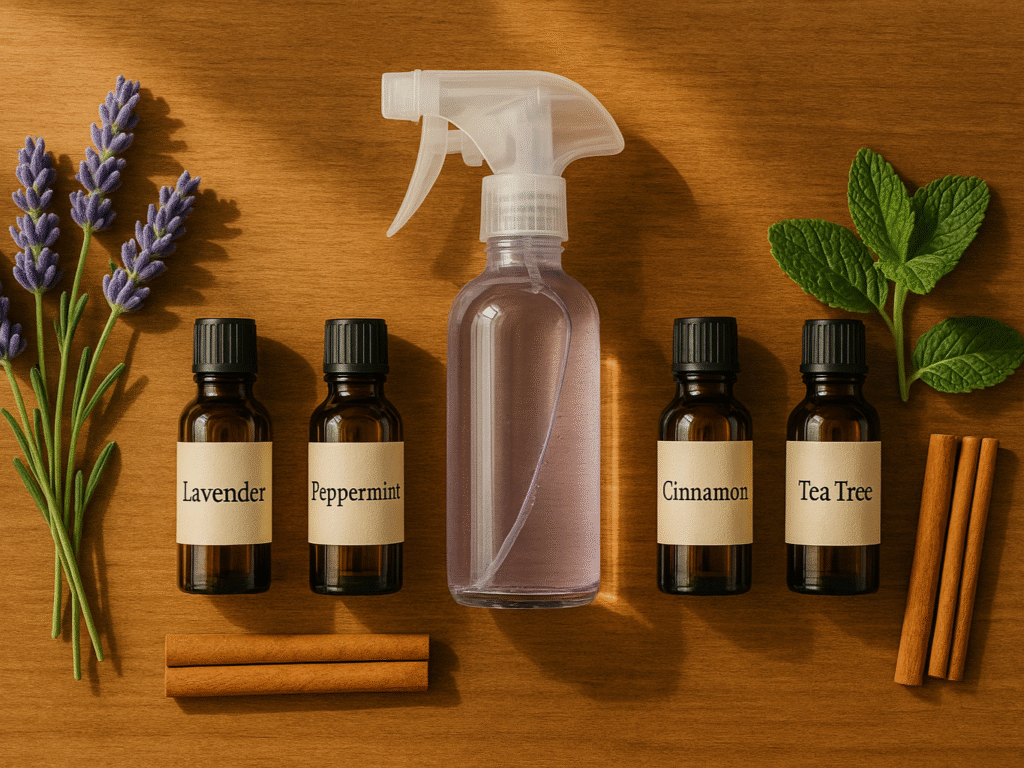
Enhancing lavender’s effectiveness against ants occurs when it is paired with other natural repellents. Strategic combinations create more powerful solutions than using any single oil alone, giving you better results for those persistent ant problems.
1. Why mixing oils can improve results.
Blending multiple essential oils creates a more comprehensive barrier against ants. Each oil contains unique compounds that affect ants differently; therefore, combining them targets various aspects of ant behavior simultaneously. For instance, while lavender disrupts scent trails, other oils, such as peppermint, create additional sensory barriers that ants strongly avoid.
Combined oils often produce a synergistic effect, meaning the mixture works more effectively than the sum of its parts. This synergy occurs because different oils attack various aspects of ant physiology and behavior, from disrupting their navigation to making treated areas completely inhospitable.
Additionally, oil combinations can address the potential adaptation issue. Research indicates that ants may eventually become less responsive to a single oil with repeated exposure. By using multiple oils, you create a more complex deterrent that remains effective for a longer period.
2. Best combinations: lavender + peppermint, cinnamon, or tea tree
Among the most effective combinations, lavender paired with peppermint stands out as exceptionally powerful. This duo creates a pervasive barrier that effectively breaks ant scent trails and deters new invasions. Mix several drops of each oil with water in a spray bottle to create an effective natural insect repellent.
The lavender-cinnamon combination offers another potent option. Cinnamon’s strong scent is particularly unappealing to ants, making this pairing ideal for creating boundaries at entry points. You can either spread ground cinnamon along with lavender oil applications or mix cinnamon essential oil with lavender in a spray.
Lavender and tea tree oil together form a powerful team against ants—tea tree oil functions as an excellent natural deterrent to numerous ant species. For households without pets, this combination proves highly effective at controlling persistent infestations.
3. When to use single oils vs. blends
Single oil applications are most effective for minor ant problems or as preventive measures in low-risk areas. Lavender oil alone often suffices for maintenance once a major infestation has been addressed.
Conversely, oil blends become necessary when dealing with established ant colonies or persistent invasions. The multiple-oil approach creates more substantial barriers that even determined ants rarely cross. Consider using blends along primary entry points or in areas with recurring ant problems.
Ultimately, your choice between single oils and blends should reflect both the severity of your ant problem and specific household considerations, such as pets, children, and individuals with sensitive skin.
Cat Safe Ant Repellent Homemade: 5 Easy Recipes You Can Try Today. Cat owners need special considerations for ant control. These feline-safe recipes provide effective ant deterrence without compromising your cat’s health, featuring ingredients that are both powerful and pet-friendly. Access cat-safe ant repellent recipes now.
Final Thoughts
Lavender is more than just a sweet-smelling herb; it’s a natural ant repellent that works. Its intense aroma devastates ants’ senses and disrupts their chemical trails. Unlike harsh chemicals, lavender offers pest control with a pleasant scent. Use it to manage ant problems while keeping your home smelling fresh, chemical-free, and safe for pets and children.
Ants rely on scent trails to navigate and locate food. Lavender oil interrupts this communication by blocking those pheromone signals. Scout ants get confused and fail to mark paths, effectively stopping infestations before they start. Applying lavender at entry points, along baseboards, and near food storage builds a natural barrier and helps keep your kitchen ant-free.
You can repel ants using lavender sprays, soaked cotton balls, or DIY oil blends. Combine lavender with peppermint, cinnamon, or tea tree oil for stronger results. These blends amplify the repellent effect and create a multi-sensory deterrent. Safer than toxic pesticides, lavender gives you a gentle, eco-friendly way to protect your home from unwanted ants.
FAQs on Lavender ant repellent
Q1. Is lavender effective at repelling ants?
Yes, lavender is an effective natural ant repellent. Its strong aroma disrupts ants’ scent trails and interferes with their navigation, making it difficult for them to locate food sources or establish paths into your home.
Q2. How can I use lavender oil to deter ants?
You can create a simple lavender spray by mixing 10-15 drops of lavender essential oil with a cup of water in a spray bottle. Apply this solution around entry points, baseboards, and areas where ants are commonly seen. Alternatively, you can place lavender oil-soaked cotton balls near ant trails.
Q3. What other natural oils work well with lavender for ant control?
Peppermint, tea tree, and cinnamon oils combine well with lavender for enhanced ant repellent properties. These combinations create a more potent barrier that ants find difficult to cross, often yielding better results than using lavender alone.
Q4. How often should I reapply lavender-based ant repellents?
For optimal effectiveness, reapply lavender-based solutions every 3-5 days, especially in high-traffic areas or during peak ant season. Regular reapplication ensures consistent protection against ant invasions.

